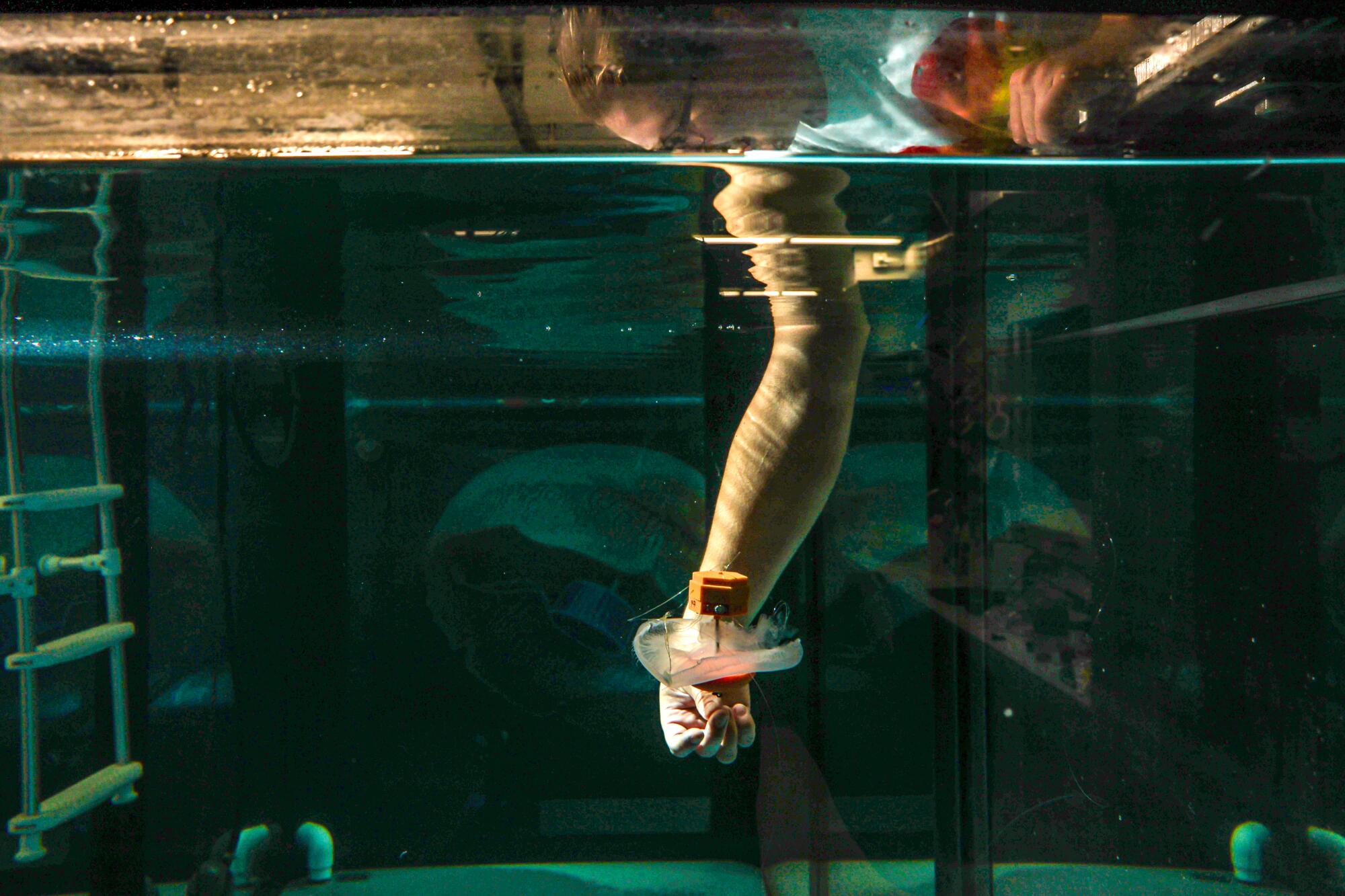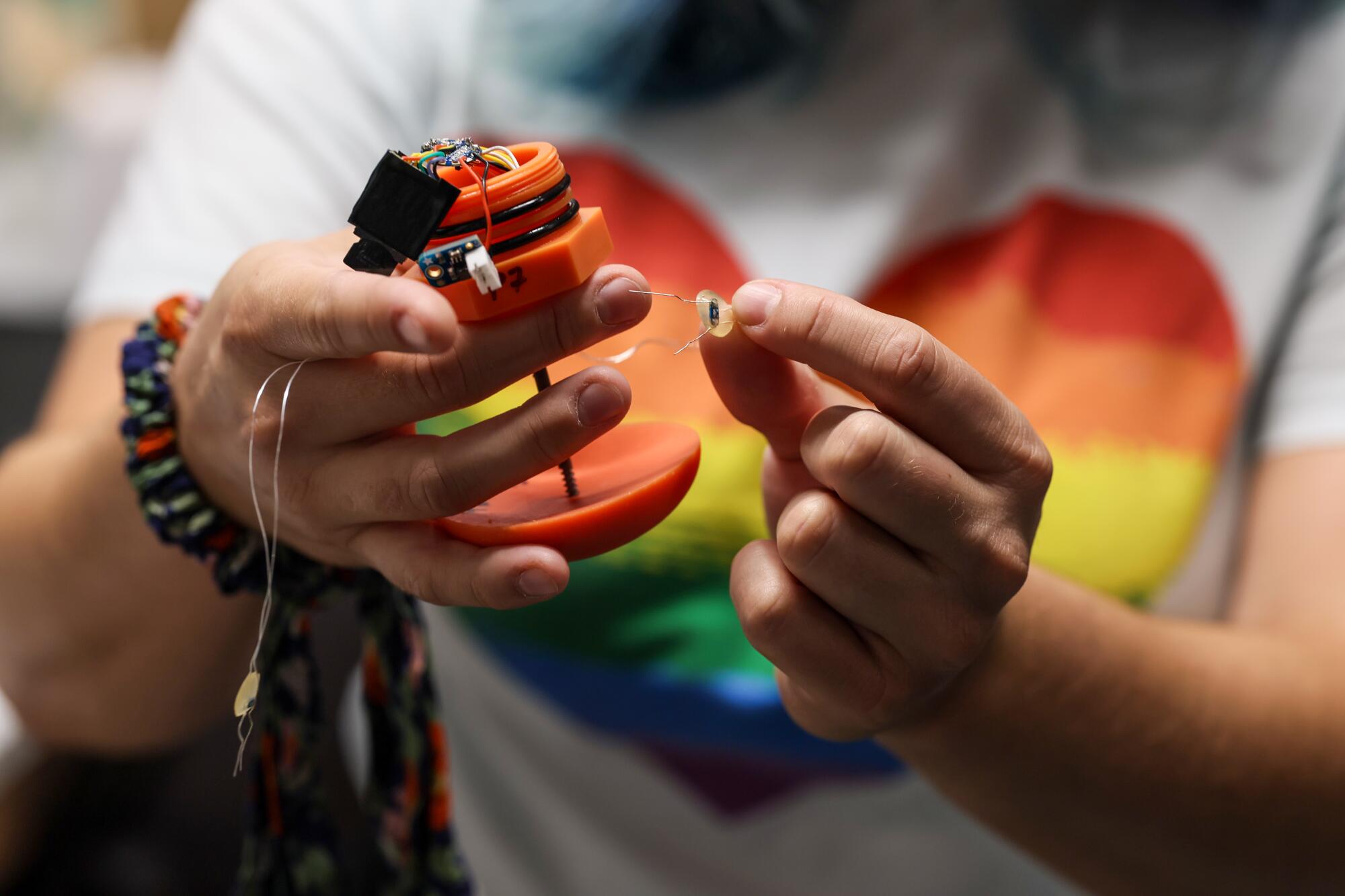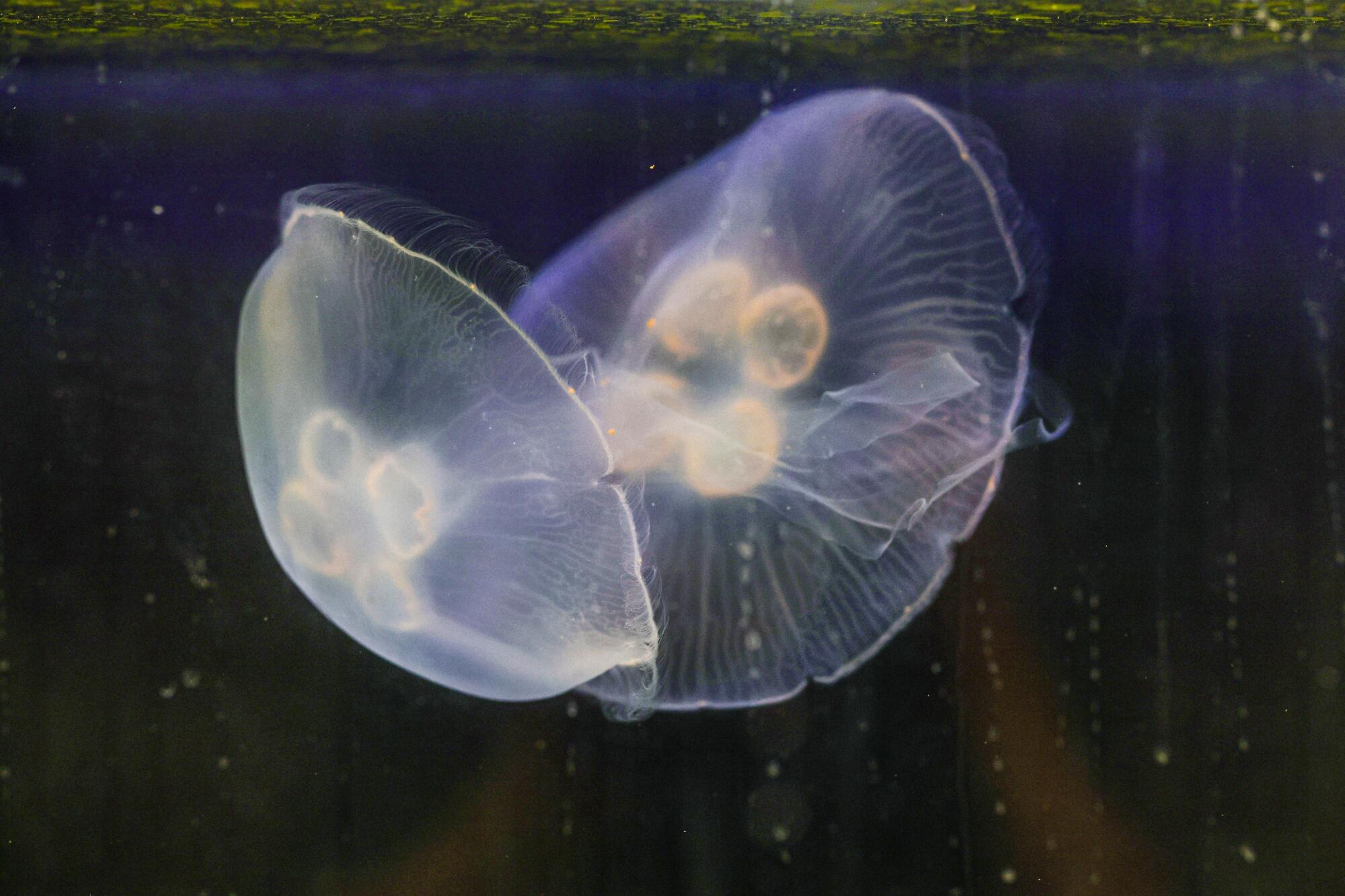For years, science fiction has promised a future crammed with robots that may swim, crawl and fly like animals. In a single analysis lab at Caltech, what as soon as felt like distant creativeness is changing into actuality.
At first look, they appear like every other moon jellyfish — soft-bodied, translucent and ghostlike, as their bell-shaped our bodies pulse gently by way of the water. However look nearer, and also you’ll spot a tangle of wires, a flash of orange plastic, and a sudden intentional motion.
These aren’t any abnormal jellies. These are cyborgs.
On the Dabiri Lab at Caltech, which focuses on the examine of fluid dynamics and bio-inspired engineering, researchers are embedding microelectric controllers into jellyfish, creating “biohybrid” gadgets. The plan: Dispatch these remotely managed jellyfish robots to gather environmental knowledge at a fraction of the price of typical underwater robots — and probably redefine how we monitor the ocean.

Caltech graduate scholar, Noa Yoder, a graduate scholar is likely one of the members of a staff growing cyborg jellyfish, utilizing a tool made up of a container crammed with sensors and two electrodes that connect to the jellyfish’s muscle groups.
“It fills the niche between high-tech underwater robots and just attaching sensors to animals, which you have little control over where they go,” stated Noa Yoder, a graduate scholar within the Dabiri Lab. “These devices are very low cost and it would be easy to scale them to a whole swarm of jellyfish, which already exist in nature.”
Jellyfish are excellent for the job in different methods: In contrast to most marine animals, jellyfish haven’t any central nervous system and no ache receptors, making them superb candidates for cybernetic augmentation. Additionally they exhibit outstanding regenerative skills, able to regrowing misplaced physique elements and reverting to earlier life levels in response to damage or stress — they will heal in as rapidly as 24 hours after the elimination of a tool.
The venture started almost a decade in the past with Nicole Xu, a former graduate scholar within the Dabiri Lab who’s now a professor on the College of Colorado Boulder. Her analysis has demonstrated that electrodes embedded into jellyfish can reliably set off muscle contractions, setting the stage for subject checks and early demonstrations of the gadget. Later, one other Caltech graduate scholar, Simon Anuszczyk, confirmed that including robotic attachments to jellyfish — typically even bigger than the jellyfish themselves — didn’t essentially impair the animals’ swimming. And actually, if designed accurately, the attachments may even enhance their pace and mobility.

The gadget permits the scientists to pilot the jellyfish by way of ocean waters and document measurements of pH, temperature, salinity, and so forth.
There have been a number of iterations of the robotic element, however the basic idea of every is similar: a central unit which homes the sensors used to gather info, and two electrodes hooked up through wires. “We attach [the device] and send electric signals to electrodes embedded in the jellyfish,” Yoder defined. “When that signal is sent, the muscle contracts and the jellyfish swims.” By triggering these contractions in a managed sample, researchers are capable of affect how and when the jellyfish transfer — permitting them to navigate by way of the water and accumulate knowledge in particular areas.

These cyborg gadgets provide a less expensive (and extra sustainable) choice for marine analysis, making it extra extensively accessible for anybody seeking to examine the ocean.
The staff hopes this venture will make ocean analysis extra accessible — not only for elite establishments with multimillion-dollar submersibles, however for smaller labs and conservation teams as nicely. As a result of the gadgets are comparatively low-cost and scalable, they might open the door for extra frequent, distributed knowledge assortment throughout the globe.
The most recent model of the gadget features a microcontroller, which sends the sign to stimulate swimming, together with a strain sensor, a temperature sensor and an SD card to log knowledge. All of which inserts inside a watertight 3D-printed construction concerning the measurement of a half greenback. A magnet and exterior ballast preserve it neutrally buoyant, permitting the jellyfish to swim freely, and correctly oriented.
One limitation of the most recent iteration is that the jellyfish can solely be managed to maneuver up and down, because the gadget is weighted to keep up a hard and fast vertical orientation, and the system lacks any mechanism to steer horizontally. One among Yoder’s present tasks seeks to deal with this problem by implementing an inside servo arm, a small motorized lever that shifts the interior weight of the gadget, enabling directional motion and mid-swim rotations.

In contrast to most marine animals, jellyfish haven’t any central nervous system and no ache receptors, making them superb candidates for cybernetic augmentation.
However maybe the most important limitation is the integrity of the gadget itself. “Jellyfish exist in pretty much every ocean already, at every depth, in every environment,” stated Yoder.
To take full benefit of that pure vary, nonetheless, the expertise must catch up. Whereas jellyfish can swim beneath crushing deep-sea pressures of as much as 400 bar — roughly the identical as having 15 African elephants sit within the palm of your hand — the 3D-printed constructions warp at such depths, which might compromise their efficiency. So, Yoder is engaged on a deep-sea model utilizing pressurized glass spheres, the identical type used for deep-sea cabling and robotics.
Different present tasks embrace finding out the fluid dynamics of the jellyfish itself. “Jellyfish are very efficient swimmers,” Yoder stated. “We wanted to see how having these biohybrid attachments affects that.” That would result in augmentations that make future cyborg jellyfish much more helpful for analysis.
The analysis staff has additionally begun working with a wider vary of jellyfish species, together with upside-down Cassiopeia jellies discovered within the Florida Keys and field jellies native to Kona, Hawaii. The objective is to search out native species that may be tapped for regional tasks — utilizing native animals minimizes ecological danger.
“This research approaches underwater robotics from a completely different angle,” Yoder stated. “I’ve always been interested in biomechanics and robotics, and trying to have robots that imitate wildlife. This project just takes it a step further. Why build a robot that can’t quite capture the natural mechanisms when you can use the animal itself?”


